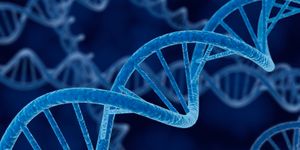Genetics & Genomics
Aging Releases Parasitic DNA Strands in Mice
DEC 25, 2013 12:00 AM PST
Share
High-Energy Variations of Table Salt Show Exciting Possibilities
 The rules of chemistry have been well understood for ages. It's also known that under extreme conditions of temperature/pressure that these rules aren't always followed, creating unusual chemical variations. Assumptions inherent in the rules of classical chemistry may break down under extreme high-energy conditions and allow for chemical configurations that couldn't be formed normally.
The rules of chemistry have been well understood for ages. It's also known that under extreme conditions of temperature/pressure that these rules aren't always followed, creating unusual chemical variations. Assumptions inherent in the rules of classical chemistry may break down under extreme high-energy conditions and allow for chemical configurations that couldn't be formed normally.A recent article in Science covers one journey into the oddities of high-pressure chemistry using the most ordinary of compounds-sodium chloride, or common table salt.
Researchers from Stony Brook University and the Carnegie Institution of Science teamed up to model and produce variations of sodium chloride under extreme conditions. Using algorithms and new computational methods to predict the possible changes that could occur to sodium chloride under high pressure, the team identified several combinations that were more likely to occur, and produced them in a stable form under the predicted conditions. The program used to predict these new compounds is called USPEX, short for Universal Structure Predictor: Evolutionary Xrystallography.
Sodium chloride (NaCl) is a great choice for study, as it forms simple cubic crystals and has an inherently stable formation through a simple ionic bond (from the donation of one extra electron of sodium to the chlorine atom that is deficient by one electron, forming a stable electron configuration around both atoms as expected by the octet rule).
By starting with simple rock salt and introducing small amounts of either sodium or chlorine to adjust the stoichiometry, increasing the pressure to hundreds of thousands of atmospheres in a diamond anvil, and heating the samples with lasers, the research team was able to create compounds that violate the octet rule, such as NaCl3 and Na3Cl.
Not only are these compounds stable under those conditions, but due to the variations from the classic crystal structure, they can have unusual, and potentially beneficial, properties. For example, the compound Na3Cl has a layered structure with one layer of NaCl and another containing only sodium. This structure combines an electrically conducting layer (sodium) with an insulating dielectric layer (NaCl). Such configurations, if stable, are extremely useful in microelectronic and nanotechnology applications.
Several interesting implications follow from this research. First, the ability to predict these unusual compounds, and subsequently produce and verify them is a major milestone. There are other chemistries to model, with many more interesting phase diagrams than sodium chloride. The possibilities are almost endless, and a method of predicting crystal structures with useful properties can guide the research down a more practical path.
Another objective is to answer questions about minerals found deep within the Earth, where temperatures and pressures can meet or exceed those used in the research. A better understanding of the mechanisms and continued use of modeling tools may challenge assumptions about the composition of the earth's core.
It's also likely that another branch of research will be devoted to practical applications of any of these unusual materials. Can any of them be stabilized at much lower energy states than where they were created? If so, materials engineers will have an interesting new set of toys to play with, so to speak.
Finally, this could be thought of as a completely new branch of chemistry, with a new set of extremely high-energy rules waiting to be derived, studied, understood, and mastered. One can see why chemists and other researchers are excited to see where this approach may lead.
You May Also Like
Loading Comments...








